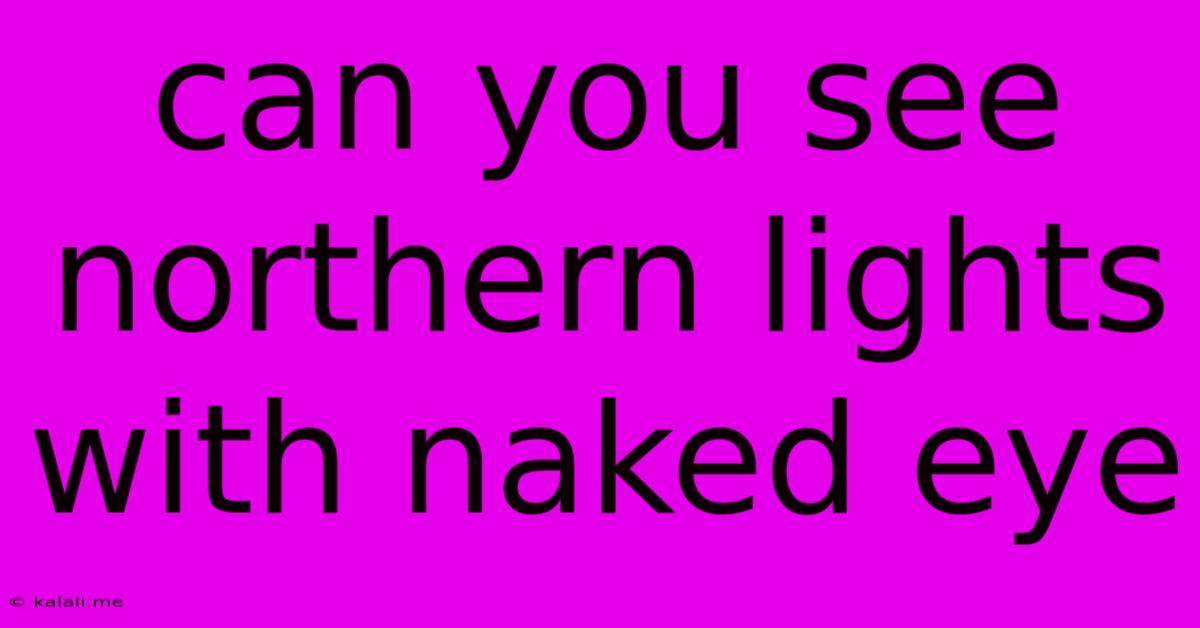Can You See Northern Lights With Naked Eye
Kalali
Jun 01, 2025 · 3 min read

Table of Contents
Can You See the Northern Lights With the Naked Eye?
The mesmerizing aurora borealis, or Northern Lights, is a bucket-list experience for many. But a common question arises: can you actually see the Northern Lights with the naked eye, or do you need special equipment? The short answer is yes, you can see the Northern Lights with the naked eye, but several factors influence how well you'll see them. This article will explore the conditions needed for optimal aurora viewing and dispel some common myths.
Understanding the Aurora Borealis
The Northern Lights are a natural light display in the sky, predominantly seen in high-latitude regions like Alaska, Canada, Scandinavia, and Iceland. They are caused by charged particles from the sun colliding with atoms in the Earth's atmosphere. This collision excites the atoms, causing them to release photons – light. The intensity and visibility of the aurora depend on several crucial factors.
Factors Affecting Naked-Eye Visibility
Several factors determine whether you'll witness a spectacular aurora display or a faint glimmer:
-
Solar Activity: The intensity of the aurora directly correlates with solar activity. Strong solar flares and coronal mass ejections send more charged particles towards Earth, resulting in brighter and more vibrant auroras. Predicting solar activity is an ongoing scientific endeavor, but various websites and apps provide real-time forecasts and aurora activity levels (KP index). A higher KP index generally indicates a stronger aurora.
-
Light Pollution: This is arguably the biggest obstacle to naked-eye aurora viewing. City lights significantly wash out the faint glow of the aurora. To maximize your chances, you need to escape urban areas and find a location with minimal light pollution. Dark sky parks and remote areas are ideal.
-
Time of Year: While the aurora can occur year-round, the long, dark winter nights provide the best viewing opportunities. The darker the sky, the easier it is to spot the aurora.
-
Weather Conditions: Clear skies are essential. Clouds will completely obscure the aurora. Checking weather forecasts before heading out is crucial.
-
Your Eyes' Adaptation: Give your eyes at least 20-30 minutes to adjust to the darkness. Avoid looking at bright screens (phones, etc.) during this time. Your peripheral vision is often better at detecting faint light changes, so try to look slightly away from the suspected aurora location.
What the Aurora Might Look Like to the Naked Eye
Depending on the intensity of the aurora, you might see anything from a faint greenish glow on the horizon to vibrant curtains of green, red, purple, and even blue dancing across the night sky. During weaker displays, the aurora may appear as a subtle brightening of the northern horizon.
Dispelling Myths About Aurora Viewing
-
You need special equipment: While cameras and specialized lenses can capture the full glory of the aurora and reveal details invisible to the naked eye, viewing the aurora itself is perfectly possible without any special equipment.
-
Auroras are always bright and colorful: While intense auroras are breathtaking, many displays are subtle and require patience and dark skies to appreciate fully.
-
You'll see the aurora every time you go to a high-latitude location: Aurora sightings depend on solar activity and weather conditions. Even in prime locations, you might not see the aurora every night.
Maximizing Your Chances of Seeing the Northern Lights
- Research dark sky locations: Find areas known for minimal light pollution.
- Check aurora forecasts: Several websites and apps provide real-time predictions of aurora activity.
- Be patient: The aurora can be unpredictable, so give yourself ample time to observe the sky.
- Dress warmly: Aurora viewing often involves spending long periods outdoors in cold weather.
- Bring a thermos of hot drinks: This will enhance your comfort during your viewing session.
In conclusion, while the experience might be enhanced with photography equipment, witnessing the magical aurora borealis with your naked eye is absolutely possible. Remember to factor in all the above conditions for optimal viewing and prepare for a potentially unforgettable experience!
Latest Posts
Latest Posts
-
How To Keep Corn Tortillas From Falling Apart
Jun 03, 2025
-
How To Wire A Ceiling Fan And Light Separately
Jun 03, 2025
-
Search For Sites That Link To A Url
Jun 03, 2025
-
Use Old Camera Module On Pi 5
Jun 03, 2025
-
Can You Push A Car In Park
Jun 03, 2025
Related Post
Thank you for visiting our website which covers about Can You See Northern Lights With Naked Eye . We hope the information provided has been useful to you. Feel free to contact us if you have any questions or need further assistance. See you next time and don't miss to bookmark.